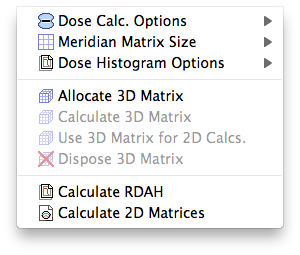The Dosimetry menu controls all aspects of the dose calculation, matrix size and so on... If items in this menu are dimmed and can not be selected it means there are no sources in the plaque or the data structure (e.g 3D dose matrix) has not yet been allocated. You should be completely familiar with each item in this menu before using this program clinically.

- Dose Calc. Options - use this hierarchical menu to set dosimetry options.
- Meridian (or coronal) Matrix Size - choose the dose matrix resolution for the currently active surface.
- Dose Histogram Options - set dose volume options.
- Allocate 3D Matrix - Allocates a 71x71x71, single precision floating point matrix surrounding the plaque. This data structure requires approximately 1.4MB RAM. If there is not enough free memory to allocate the matrix, this menu item will be disabled. If this occurs: quit the program, add system RAM if necessary and increase the MacOS "preferred" memory size for the program.
- Calculate 3D matrix - Calculates and enables the 3D matrix. Calculating a 3D matrix is time consuming on older 680x0 and PowerPC 601 processors. Type command-dot to abort a calculation.
- Use 3D matrix for 2D calcs. - When this menu item is enabled, all 2D surface and point dose calculations will be interpolated from the 3D matrix rather than explicitly calculated. If the matrix is not valid, ie. it has not been calculated or loaded, or the current dose calculation mode settings do not match the settings originally used to calculate the matrix, this menu item will be disabled.
- Dispose 3D matrix - Returns the memory used by the 3D matrix to the "heap", thereby making it available for other purposes (such as storing images). Select this ONLY if you are done with the 3D matrix and really need to free up the memory.
- Calculate RDAH - Calculates the retinal surface dose-area histogram (or, optionally, a dose-volume histogram).
- Calculate 2D Matrices - Calculates all 2D matrices. The 2D matrices are located on the transecting and/or equatorial planes and the retinal surface.